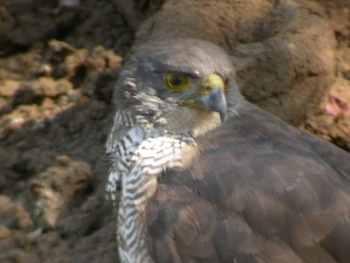Includes Red-chested Goshawk
- Aerospiza tachiro
Accipiter tachiro
Identification
The male (38 cm, 200 g) is smaller than the female (46 cm, 350 g)
The upperparts of the male are slate and the underparts are white, finely barred rufous. The male's tail is indistinctly barred, and has two white spots on the upper side.
The female has dark brown upperparts and the underparts are barred brown (less finely barred than the male).
In both sexes the cere, eyes and legs are yellow; the underwing is barred, and the underwing coverts are of a similar colour to that of the barring on the breast.
Immature birds: The underparts have brown blotches, there is a dark streak down the centre of the throat, and the eyebrow is white.
Distribution
Most of Sub-Saharan Africa: from Senegal in the West and Eritrea in the East to South Africa in the South.
Taxonomy
Subspecies
Complex. At least nine taxa have been described, including:
- Accipiter tachiro tachiro. Found in South Africa, eSwatini and Mozambique south of the Limpopo
- A. t. sparsimfasciatus. North-eastern Namibia, the extreme north and north-east of Botswana, Zimbabwe, Democratic Republic of Congo, Angola, Somalia, Tanzania and Mozambique north of the Limpopo
- A. t. unduliventer is from Eritrea and Ethiopia
- A. t. croizati is endemic to Ethiopia
- A. t. pembaensis. Pemba Island.
- A. t. toussenelii. Cameroon to western Democratic Republic of Congo.
- A. t. macroscelides. Senegal to West Cameroon.
- A. t. canescens. Central and eastern Democratic Republic of Congo.
- A. t. lopezi. Bioko Island.
Some recent authorities (Kemp & Kemp 1998, Borrow & Demey 2001, 2004, Ferguson-Lees & Christie 2001, Allan 2005) regard all these taxa as constituting a single species. Others (Kemp 1994, Clark & Davies 2000, Sinclair & Ryan 2003) regard the latter four taxa as a separate species, Red-chested Goshawk Accipiter toussenelli. Louette (2010) has suggested that the whole complex be regarded as a ‘superspecies’ with the A. tachiro and A. toussenelli clades recognised as separate ‘paraspecies’, since the two have phylogenetic, morphological and habitat preference differences, and have not been proved to interbreed. Louette also suggests that, on molecular grounds, A. t. unduliventer may constitute a monotypic third species within the complex.
Habitat
Forest, plantations, and closed riverine woodland.
Behaviour
The African Goshawk is usually inconspicuous, but its presence is often betrayed by its call which is often given when circling high above the forest, but is also given by birds perched in the canopy of large trees.
Diet
Prey comprises mainly birds (usually bulbul size or smaller), but includes small mammals. Hunting is usually done using a quick dash from a perch in cover, and birds are caught both in flight and on the ground.
Vocalisation
Call: a sharp "tchit......tchit......tchit" (at two-second intervals) that has been likened to the click of two stones being struck together.
References
- Allan, DG, 2005, “African Goshawk Accipiter tachiro” in Hockey, PAR, Dean, WRJ & Ryan PG (eds.) Roberts Birds of Southern Africa, 7th edition. Cape Town, Trustees of the John Voelcker Bird Book Fund.
- Borrow, N & Demey, R, 2001, Birds of Western Africa. London: Christopher Helm.
- Borrow, N & Demey, R, 2004, Field Guide to the Birds of Western Africa. London: Christopher Helm.
- Clark, WS & Davies, RAG, 2000, “Taxonomic problems in African diurnal raptors” in Chancellor, RD & Meyburg B-U, Raptors at Risk. Proceedings of the 5th World Conference on Birds of Prey and Owls, Midrand, Johannesburg, South Africa, 4-11 August 1998. Berlin/Blaine: World Working Group on Birds of Prey and Owls/Hancock House Publishers.
- Ferguson-Lees, J, & Christie, DA, 2001, Raptors of the World, London: Christopher Helm.
- Hockey, PAR, WRJ Dean, and PG Ryan, eds. 2005. Roberts' Birds of Southern Africa. 7th ed. Cape Town: John Voelcker Bird Book Fund. ISBN 978-0620340533
- Kemp, AC, 1994, “Afrotropical Accipitridae” in del Hoyo, Elliot & Sargatal (eds.) Handbook of the Birds of the World, Vol. 2. Barcelona: Lynx Editions.
- Kemp, A & Kemp, M, 1998, Birds of Prey of Africa and its Islands. London: New Holland.
- Lepage D. 2007. Avibase. Search for "Accipiter tachiro" downloaded 10 October 2007.
- Louette, M, 2010, “Plumage variation in African Goshawk Accipiter tachiro and its separation from congenerics in equatorial Africa” in Bulletin of the African Bird Club, vol. 7, no. 1.
- Sinclair, I and P Ryan. 2003. Birds of Africa South of the Sahara. Princeton: Princeton Univ. Press. ISBN 978-0691118154
- Steyn P. 1982. Birds of Prey of Southern Africa. David Philip, Cape Town, South Africa, ISBN 0908396643, Tanager Books, Dover, USA, ISBN 0880720255, Croom Helm, Beckenham, UK. ISBN 0709923821.
Recommended Citation
- BirdForum Opus contributors. (2025) African Goshawk. In: BirdForum, the forum for wild birds and birding. Retrieved 12 May 2025 from https://www.birdforum.net/opus/African_Goshawk
External Links
GSearch checked for 2020 platform.1







